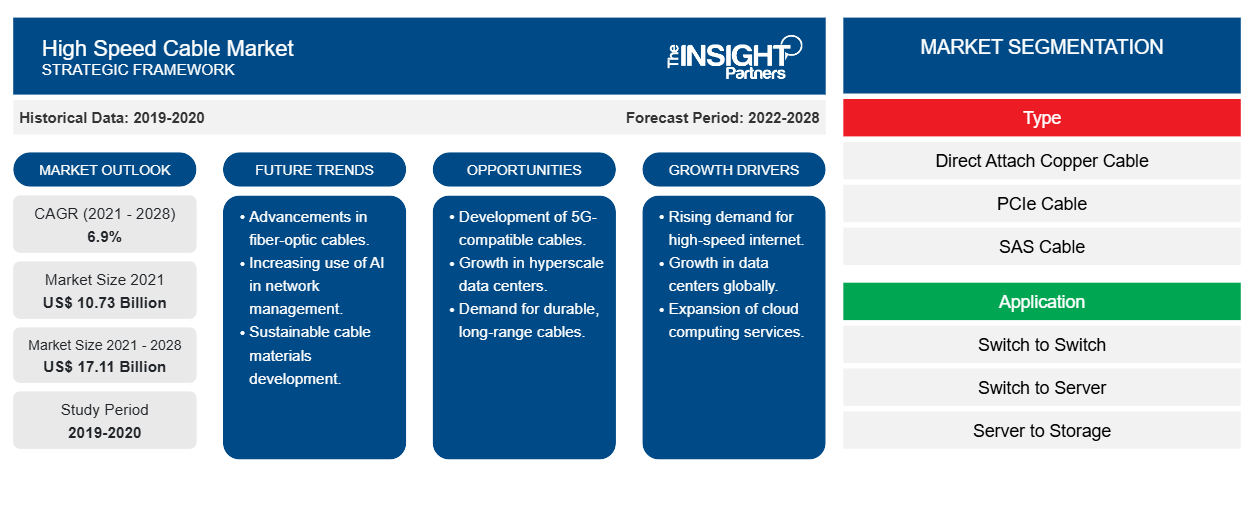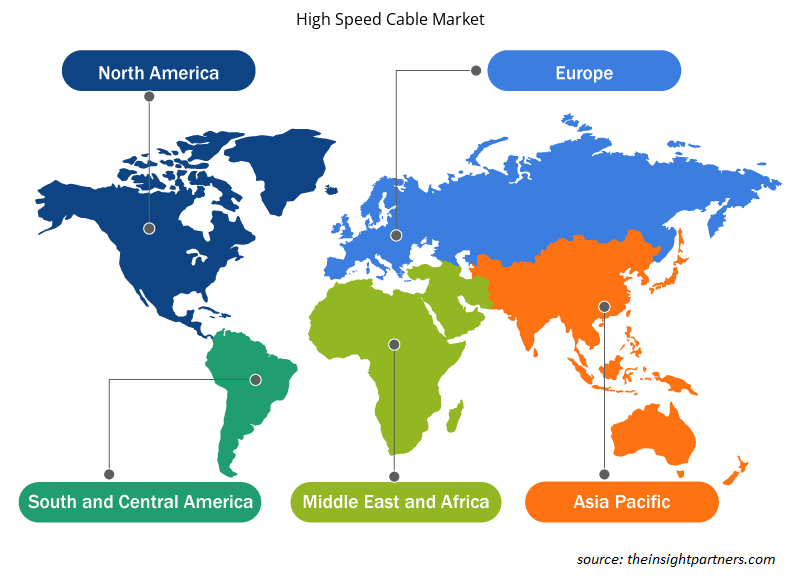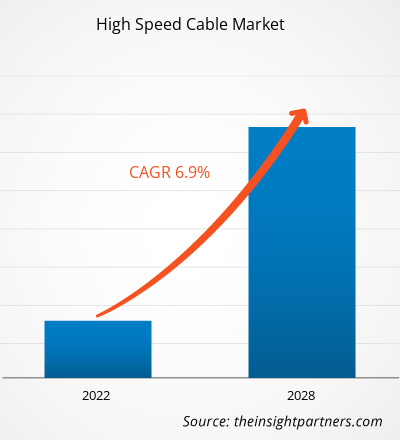Si prevede che il mercato dei cavi ad alta velocità raggiungerà i 24,99 miliardi di dollari entro il 2031, rispetto ai 12,90 miliardi di dollari del 2024. Si prevede che il mercato registrerà un CAGR del 10,2% nel periodo 2025-2031. L'avvento delle smart city porterà probabilmente nuove tendenze nel mercato nei prossimi anni.
Analisi di mercato dei cavi ad alta velocità
Con l'espansione dei servizi cloud a un ritmo senza precedenti, la domanda di interconnessioni per data center ad alte prestazioni e convenienti è in rapido aumento. Ciò ha portato alla crescente adozione di cavi ad alta velocità. A differenza delle interconnessioni ottiche che si basano su moduli ottici per la conversione del segnale, cavi ad alta velocità come i cavi Direct Attach Copper (DAC) e gli Active Optical Cables (AOC) forniscono una connessione diretta a livello fisico tra due porte utilizzando cavi biassiali. Ciò garantisce l'integrità del segnale su distanze specifiche senza la necessità di componenti ottici attivi. Settori come l'elettronica, l'automotive, le comunicazioni e il networking si stanno evolvendo, introducendo innovazioni che supportano un trasferimento dati più rapido. Di conseguenza, la crescente necessità di una connettività efficiente sta trainando la crescita del mercato dei cavi ad alta velocità . Nel settore automobilistico, i produttori stanno integrando sempre più sistemi elettronici e di infotainment nei veicoli per migliorare la connettività, alimentando ulteriormente questa domanda.
Panoramica del mercato dei cavi ad alta velocità
I data center richiedono connessioni intra-rack e inter-rack efficienti, e i cavi ad alta velocità sono ideali a questo scopo. Offrono una connettività rapida consumando meno di 0,1 W di potenza, generando un calore minimo. Questa efficienza energetica contribuisce a ridurre il carico di raffreddamento sui sistemi di condizionamento dell'aria del data center. Inoltre, i cavi ad alta velocità offrono un'eccellente durata, rendendoli meno soggetti a danni da piegatura o sollecitazioni fisiche. Questa robustezza riduce al minimo il rischio di guasti in ambienti ad alta densità, offrendo un vantaggio significativo nelle operazioni del data center.
Riceverai la personalizzazione gratuita di qualsiasi report, incluse parti di questo report, analisi a livello nazionale, pacchetto dati Excel e potrai usufruire di fantastiche offerte e sconti per start-up e università.
Mercato dei cavi ad alta velocità: approfondimenti strategici

-
Scopri le principali tendenze di mercato di questo rapporto.Questo campione GRATUITO includerà analisi di dati che spaziano dalle tendenze di mercato alle stime e alle previsioni.
Driver e opportunità del mercato dei cavi ad alta velocità
Sviluppi nei servizi di rete 5G
I DAC passivi, che sono fondamentalmente fili di rame di alta qualità senza componenti elettronici integrati, sono meno costosi dei cavi grazie a questi componenti. I chipset avanzati in AECS e i laser VCSEL in AOCS aggiungono un costo aggiuntivo che può aumentare il costo di almeno due o cinque volte. I DAC sono frequentemente utilizzati nelle reti 5G per connessioni a corto raggio che si verificano nella stessa area, come i siti di celle O-RAN e i data center edge. Questi cavi supportano il trasporto dati ad alta velocità con bassa latenza e basso consumo energetico. Ad esempio, i DAC passivi QSFP28 sono adatti per connessioni dirette in cabinet poiché possono supportare 100 Gb/s, mentre i DAC SFP28 possono supportare 25 Gb/s. La densità di celle e l'elevato traffico delle reti 5G richiedono connessioni di backhaul in grado di gestire centinaia di gigabit. Ciò richiede connessioni Ethernet a velocità maggiore, come 400 Gb/s o superiori. I DAC sono essenziali per facilitare queste connessioni Ethernet ad alta velocità su brevi distanze e garantire un trasferimento dati efficace tra i dispositivi di rete. Il consumo energetico per porta più basso è garantito anche dai DAC passivi, che consumano dal 91% al 97% in meno di energia per porta rispetto al cablaggio in fibra ottica con transceiver indipendenti. Il volume delle connessioni di accesso alla rete server a corto raggio aumenta rapidamente.DACs, which are basically premium copper wires without any embedded electronics, are less expensive than the cables due to these components. Advanced chipsets in AECS and VCSEL lasers in AOCS add a premium that can increase the cost by at least two to five times. DACs are frequently utilized in 5G networks for short-range connections that occur in the same area, such as O-RAN cell sites and edge data centers. These cables support high-speed data transport with low latency and power consumption. For instance, passive QSFP28 DACs are appropriate for in-cabinet direct connections since they can support 100 Gb/s, while SFP28 DACs can support 25 Gb/s. The dense cells and high traffic of 5G networks necessitate backhaul connections capable of handling hundreds of gigabits. This necessitates greater speed Ethernet connections, such as 400G or greater. DACs are essential in order to facilitate these high-speed Ethernet connections across short distances and guarantee effective data transfer between network devices. The lowest power consumption per port is also provided by passive DACs, which use between 91% and 97% less power per port than fiber cabling with independent transceivers. The volume of short-reach server network access connections quickly mounts up.
Crescente diffusione dei data center
L'aumento dell'utilizzo di Internet e lo sviluppo di soluzioni software avanzate hanno alimentato il volume di dati generati in tutto il mondo. La necessità di elaborare e archiviare enormi quantità di dati ha spinto le organizzazioni ad adottare soluzioni di elaborazione e archiviazione avanzate, favorendo l'implementazione di data center. Con la crescente tendenza alla digitalizzazione, i data center sono diventati un aspetto fondamentale dell'industria e dell'economia moderne. I data center svolgono un ruolo fondamentale nel cloud computing. Con l'evoluzione del settore verso l'adozione della tecnologia cloud grazie ai suoi vantaggi economici e operativi, le PMI sono in prima linea nell'adozione di questa tecnologia. Inoltre, complesse operazioni di cloud computing vengono svolte da grandi aziende tecnologiche e istituti di ricerca. Cavi ottici attivi, cavi in rame ad attacco diretto e cavi in fibra ottica sono tra i cavi ad alta velocità ampiamente utilizzati nei data center.
Analisi della segmentazione del rapporto di mercato sui cavi ad alta velocità
I segmenti chiave che hanno contribuito alla derivazione dell'analisi di mercato dei cavi ad alta velocità sono i componenti, l'utente finale e la connettività.
- In base alla tipologia, il mercato è segmentato in cavi in rame ad attacco diretto (DAC), cavi ottici attivi (AOC), cavi in rame attivi (ACC), cavi PCIe, cavi elettrici attivi (AEC) e cavi SAS. Il segmento dei cavi ottici attivi (AOC) deteneva la quota di mercato maggiore nel 2024.
- In base all'applicazione, il mercato è segmentato in interconnessione switch-to-switch, switch-server e interconnessione server-storage. Il segmento di interconnessione switch-to-switch deteneva la quota maggiore del mercato nel 2024.
Analisi della quota di mercato dei cavi ad alta velocità per area geografica
L'ambito geografico del rapporto sul mercato dei cavi ad alta velocità è suddiviso in cinque regioni: Nord America, Asia Pacifico, Europa, Medio Oriente e Africa, e Sud e Centro America.
L'Asia-Pacifico ha detenuto una quota di mercato significativa nel 2024. L'Asia-Pacifico è la regione in più rapida crescita per la domanda di cavi ad alta velocità, grazie alla rapida urbanizzazione, alla crescita esponenziale degli utenti Internet e ai progressi tecnologici in paesi come Cina, Giappone, Corea del Sud e India. L'espansione delle reti 5G, la costruzione di data center su larga scala e il fiorente mercato dei veicoli elettrici stanno creando notevoli opportunità per l'implementazione di cavi ad alta velocità nei settori delle telecomunicazioni, dei trasporti e dell'energia.
L'industria automobilistica nella regione Asia-Pacifico contribuisce in modo significativo alla crescente domanda di cavi ad alta velocità. In Cina, Giappone, Corea del Sud e altri paesi, le case automobilistiche richiedono cavi ad alta velocità per la trasmissione di dati di immagini, display multifunzione e sistemi di infotainment per i passeggeri dei sedili posteriori, oltre ad altre applicazioni, con l'avvento dei veicoli elettrici (EV). La Cina, in quanto principale mercato globale di veicoli elettrici, si pone obiettivi ambiziosi per la mobilità elettrica, alimentando la domanda di componenti ad alte prestazioni. Secondo l'Agenzia Internazionale per l'Energia (IEA), la significativa crescita dell'adozione di veicoli elettrici (EV) in Cina, con nuove immatricolazioni di auto elettriche che raggiungeranno gli 8,1 milioni nel 2023, con un aumento del 35% rispetto al 2022, evidenzia la crescente domanda di cavi ad alta velocità nel settore automobilistico. Questo aumento della produzione di veicoli elettrici è strettamente legato all'aumento dei cavi ad alta velocità, in particolare nella regione Asia-Pacifico. I cavi ad alta velocità nelle applicazioni automobilistiche facilitano la trasmissione rapida dei dati per funzionalità quali sistemi avanzati di assistenza alla guida (ADAS), sistemi di infotainment e sistemi di telecamere. Consentono inoltre le comunicazioni tra veicoli (V2V) e tra veicoli e infrastrutture (V2X).
Approfondimenti regionali sul mercato dei cavi ad alta velocità
Le tendenze e i fattori regionali che influenzano il mercato dei cavi ad alta velocità durante il periodo di previsione sono stati ampiamente spiegati dagli analisti di Insight Partners. Questa sezione illustra anche i segmenti e la geografia del mercato dei cavi ad alta velocità in Nord America, Europa, Asia-Pacifico, Medio Oriente e Africa, e Sud e Centro America.

- Ottieni i dati specifici regionali per il mercato dei cavi ad alta velocità
Ambito del rapporto di mercato sui cavi ad alta velocità
| Attributo del report | Dettagli |
|---|---|
| Dimensioni del mercato nel 2024 | 12,90 miliardi di dollari USA |
| Dimensioni del mercato entro il 2031 | 24,99 miliardi di dollari USA |
| CAGR globale (2025-2031) | 10,2% |
| Dati storici | 2021-2023 |
| Periodo di previsione | 2025-2031 |
| Segmenti coperti |
Per tipo
|
| Regioni e paesi coperti |
America del Nord
|
| Leader di mercato e profili aziendali chiave |
|
Densità degli operatori del mercato dei cavi ad alta velocità: comprendere il suo impatto sulle dinamiche aziendali
Il mercato dei cavi ad alta velocità è in rapida crescita, trainato dalla crescente domanda degli utenti finali, dovuta a fattori quali l'evoluzione delle preferenze dei consumatori, i progressi tecnologici e una maggiore consapevolezza dei vantaggi del prodotto. Con l'aumento della domanda, le aziende stanno ampliando la propria offerta, innovando per soddisfare le esigenze dei consumatori e sfruttando le tendenze emergenti, alimentando ulteriormente la crescita del mercato.
La densità degli operatori di mercato si riferisce alla distribuzione delle imprese che operano in un determinato mercato o settore. Indica quanti concorrenti (operatori di mercato) sono presenti in un determinato spazio di mercato in relazione alle sue dimensioni o al suo valore totale.
Le principali aziende che operano nel mercato dei cavi ad alta velocità sono:
- Amphenol Corporation
- Cavo Axon SAS
- Molex LLC
- Volex PLC
- NVIDIA CORPORATION
- Samtec INC
Disclaimer : le aziende elencate sopra non sono classificate secondo alcun ordine particolare.

- Ottieni una panoramica dei principali attori del mercato dei cavi ad alta velocità
Notizie di mercato e sviluppi recenti sui cavi ad alta velocità
Il mercato dei cavi ad alta velocità viene valutato raccogliendo dati qualitativi e quantitativi a valle di ricerche primarie e secondarie, che includono importanti pubblicazioni aziendali, dati di associazioni e database. Di seguito sono elencati alcuni sviluppi nel mercato dei cavi ad alta velocità:
- Amphenol Communications Services (ACS), leader globale nelle soluzioni di interconnessione ad alte prestazioni, e Semtech Corporation (Nasdaq: SMTC), fornitore leader di semiconduttori ad alte prestazioni, sistemi per l'Internet of Things (IoT) e soluzioni per servizi di connettività cloud, hanno presentato un cavo in rame attivo (ACC) OSFP da 1,6 T all'avanguardia, dotato di circuiti integrati equalizzatori/redriver lineari CopperEdge 224G/lane di Semtech, destinato all'uso in infrastrutture di prossima generazione per intelligenza artificiale/apprendimento automatico e data center. (Fonte: Amphenol Communications, comunicato stampa, aprile 2025)
- Samtec ha pubblicato una nuova Guida alla progettazione di cavi ad alta velocità ricca di nuovi prodotti, tecnologie e roadmap. La Guida evidenzia l'innovazione di Samtec per le architetture di nuova generazione: soluzioni Flyover, HDR, Ottica e RF, combinate con un supporto leader del settore, produzione interna e capacità di personalizzazione per creare una soluzione adatta a qualsiasi applicazione. (Fonte: Samtec, comunicato stampa, giugno 2023)
Copertura e risultati del rapporto sul mercato dei cavi ad alta velocità
Il rapporto "Dimensioni e previsioni del mercato dei cavi ad alta velocità (2021-2031)" fornisce un'analisi dettagliata del mercato che copre le seguenti aree:
- Dimensioni e previsioni del mercato dei cavi ad alta velocità a livello globale, regionale e nazionale per tutti i principali segmenti di mercato coperti dall'ambito
- Tendenze del mercato dei cavi ad alta velocità, nonché dinamiche di mercato quali driver, vincoli e opportunità chiave
- Analisi PEST e SWOT dettagliate
- Analisi di mercato dei cavi ad alta velocità che copre le principali tendenze del mercato, il quadro globale e regionale, i principali attori, le normative e i recenti sviluppi del mercato
- Analisi del panorama industriale e della concorrenza che copre la concentrazione del mercato, l'analisi della mappa termica, i principali attori e gli sviluppi recenti per il mercato dei cavi ad alta velocità
- Profili aziendali dettagliati
- Analisi storica (2 anni), anno base, previsione (7 anni) con CAGR
- Analisi PEST e SWOT
- Valore/volume delle dimensioni del mercato - Globale, Regionale, Nazionale
- Industria e panorama competitivo
- Set di dati Excel
Report recenti
Testimonianze
Motivo dell'acquisto
- Processo decisionale informato
- Comprensione delle dinamiche di mercato
- Analisi competitiva
- Analisi dei clienti
- Previsioni di mercato
- Mitigazione del rischio
- Pianificazione strategica
- Giustificazione degli investimenti
- Identificazione dei mercati emergenti
- Miglioramento delle strategie di marketing
- Aumento dell'efficienza operativa
- Allineamento alle tendenze normative






















 Ottieni un campione gratuito per - Mercato dei cavi ad alta velocità
Ottieni un campione gratuito per - Mercato dei cavi ad alta velocità